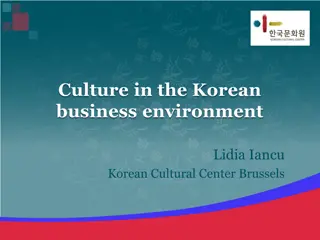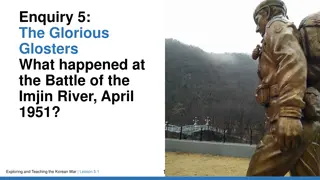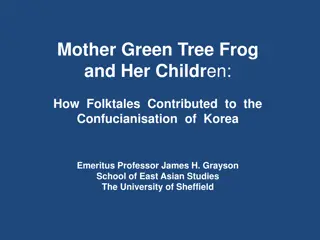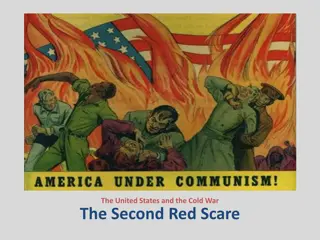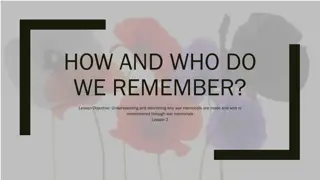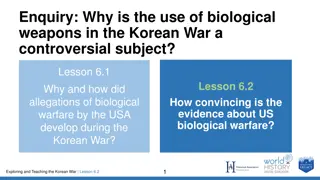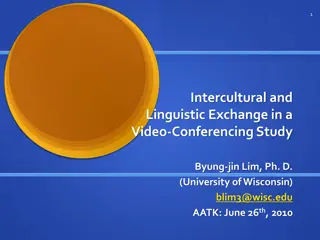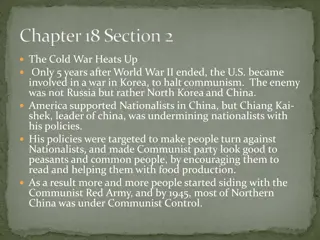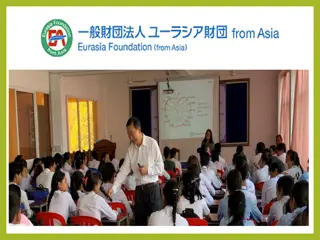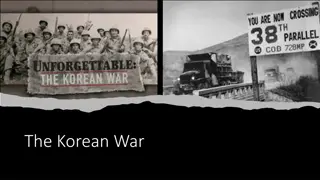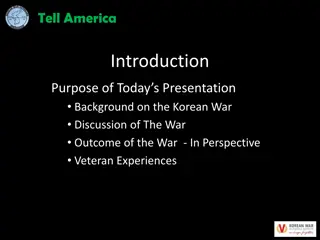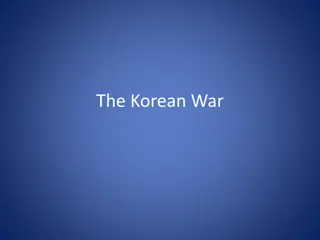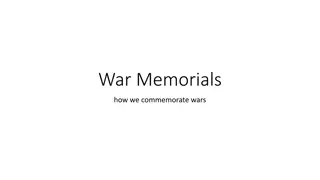Memorials of the Korean War
Explore various memorials dedicated to the Korean War, including the Korean Veterans Memorial in the UK, the Chinese Communist Memorial, the Statue of Brothers in Seoul, and the US Korean War Veterans Memorial in Washington DC. Each memorial tells a unique story about the conflict and the involvement of different nations in the war, serving as reminders of sacrifice, unity, and peace efforts.
Download Presentation

Please find below an Image/Link to download the presentation.
The content on the website is provided AS IS for your information and personal use only. It may not be sold, licensed, or shared on other websites without obtaining consent from the author. Download presentation by click this link. If you encounter any issues during the download, it is possible that the publisher has removed the file from their server.
E N D
Presentation Transcript
Resource sheet 3.3A Korean Veterans Memorial, National Memorial Arboretum, UK The memorial includes four boulders, each representing one of the four years in which the British Armed Forces participated in the Korean War from 1950 to 1953. Each boulder has a metal plaque on it, explaining what happened in each year. There are three flags flying, those of Britain, South Korea and the United Nations. Surrounding the memorial are 25 trees that typically grow in Korea. The memorial was opened in 2000 by the Korean Veterans Association on the fiftieth anniversary of the outbreak of the Korean War in 1950. Exploring and Teaching the Korean War | Lesson 3.3
Resource sheet 3.3A Chinese communist memorial to the Korean War The memorial shows General Peng Dehuai leading Chinese soldiers across the Yalu River from the border city of Dandong in October 1950. The soldiers were sent to help North Korea fight UN forces, who were close to the Chinese border and might threaten communist China itself. Chinese troops helped to push back the UN troops. The soldiers were officially known as volunteers , which avoided the Chinese government having to declare war against UN forces. For Peace is written in English and Chinese at the foot of the statue. Chinese support for North Korea was meant to end the war and so bring peace to the whole of Korea. The Chinese saved North Korea from defeat. In China, the Korean War is known as the War to resist US aggression and aid Korea . The memorial forms part of a museum about Chinese involvement in the Korean War. The museum was built in Dandong in the 1990s. 2 Exploring and Teaching the Korean War | Lesson 3.3
Resource sheet 3.3A The Statue of Brothers in Seoul The statue shows two soldiers embracing across a split concrete dome. The taller, well-armed soldier with a helmet represents a South Korean soldier reunited on a battlefield with his younger, unarmed smaller brother from the North Korean Army. The split concrete dome represents a Korea still divided between two states. The inside of the dome includes a floor map showing 16 allies from United Nations forces who assisted South Korea in its war with North Korea and communist China. The memorial is intended to show the past sufferings of the Korean people and their determination to achieve national harmony, unity and prosperity. The memorial was opened in 1994, after South Korea became a democracy in 1987. 3 Exploring and Teaching the Korean War | Lesson 3.3
Resource sheet 3.3A US Korean War Veterans Memorial, Washington DC This memorial shows 19 larger-than-life stainless steel statues of members of the US Armed Forces in combat gear, warily crossing a field during the Korean War. The ground is planted with low-lying juniper bushes to look like a Korean rice paddy field. The statues deliberately include all the different ethnic groups who served in the American army, e.g. African-Americans, Native Americans, etc. There are no statues of other nationalities or of South Korean civilians (although the countries who took part as US allies are listed on another part of the memorial). The memorial was opened in 1995 by the US and South Korean presidents. In 2015, Samsung, a South Korean company, paid money for the maintenance of the monument. 4 Exploring and Teaching the Korean War | Lesson 3.3
Resource sheet 3.3A Korean War memorial in the port of Cartagena, Colombia, South America The metal sculpture shows a sixteenth-century Korean ship called a Geobuksean (a turtle ship). This was used to defend the country against a Japanese invasion. The ship stands on a stone platform, which includes a plaque and sculptures of cannons. Two flagpoles come out of the ship flying the Colombian and South Korean flags. The memorial is located in Cartagena because Colombian troops who were sent to support United Nations forces started their sea journey to Korea from Cartagena. Colombia was the only South American country to take part in the Korean War. The memorial links how Korea resisted Japanese aggression in the sixteenth century with how Colombia helped South Korea to resist North Korean aggression in the twentieth century. The memorial was paid for by the South Korean government and built in 2016. 5 Exploring and Teaching the Korean War | Lesson 3.3
Resource sheet 3.3A Memorial at the Victorious Fatherland Liberation War Museum, Pyongyang, North Korea This group of larger-than-life statues show North Korean soldiers charging fiercely behind a North Korean flag. In North Korean propaganda, the Korean War is referred to as a war of liberation to free South Korea from its puppet government and US occupation. It is described as a victorious war, thanks to the brilliant leadership of Kim Il-sung, North Korea s first communist dictator. At different times since the war, North Korea has sometimes mentioned Chinese military support, which helped it to survive, and sometimes claimed victory just for itself. The museum was built on its present site in 1963. 6 Exploring and Teaching the Korean War | Lesson 3.3





